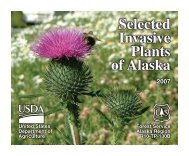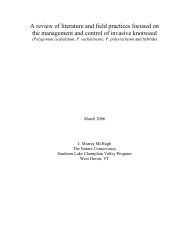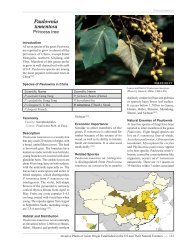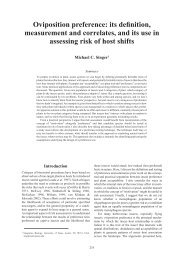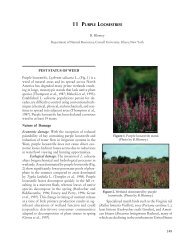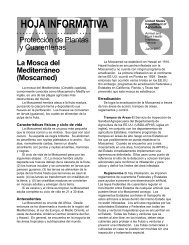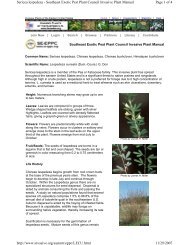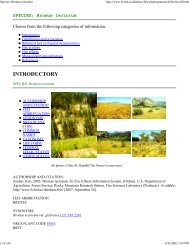Commelina communis
Commelina communis
Commelina communis
You also want an ePaper? Increase the reach of your titles
YUMPU automatically turns print PDFs into web optimized ePapers that Google loves.
<strong>Commelina</strong> <strong>communis</strong><br />
<strong>Commelina</strong> <strong>communis</strong><br />
Asiatic dayflower<br />
Introduction<br />
The genus <strong>Commelina</strong> has approximately<br />
100 species worldwide, distributed<br />
primarily in tropical and temperate<br />
regions. Eight species occur in<br />
China [60][167] .<br />
Species of <strong>Commelina</strong> in<br />
China<br />
Scientific Name<br />
Scientific Name<br />
C. auriculata Bl. C. maculata Edgew.<br />
C. bengalensis L. C. paludosa Bl.<br />
C. <strong>communis</strong> L. C. suffruticosa Bl.<br />
C. diffusa Burm. f. C. undulata R. Br.<br />
Taxonomy<br />
Family: <strong>Commelina</strong>ceae<br />
Genus: <strong>Commelina</strong> L.<br />
Description<br />
<strong>Commelina</strong> <strong>communis</strong> is an annual<br />
herb with numerous branched, creeping<br />
stems, which are minutely pubescent<br />
distally, 1 m long. Leaves are lanceolate<br />
to ovate-lanceolate, 3–9 cm long and<br />
1.5–2 cm wide. Involucral bracts<br />
grow opposite the leaves. Bracts are<br />
1.2–2.5 cm long, folded and cordate<br />
when unfolded, with 1.5–4 cm long<br />
stalk, often hirsute-ciliate marginally,<br />
and acute apically. Cyme inflorescence<br />
has one flower near the top, with dark<br />
blue petals and membranous sepals 5<br />
mm long. Capsules are elliptic, 5–7<br />
mm, and two-valved. The two seeds<br />
in each valve are brown-yellow, 2–3<br />
mm long, irregularly pitted, flat-sided,<br />
and truncate at one end [60][167] .<br />
Habitat<br />
C. <strong>communis</strong> prefers moist, shady forest<br />
edges. It is common in wet areas of<br />
crop fields, orchards, ditches, and<br />
Flower of <strong>Commelina</strong> <strong>communis</strong>. (Photo provided<br />
by LBJWC, Albert, F. W. Frick, Jr.)<br />
roadsides [60] .<br />
Distribution<br />
C. <strong>communis</strong> is widely distributed in<br />
China, [60] but no records are reported<br />
for its distribution in Qinghai, Xinjiang,<br />
Hainan, and Tibet [6][116][167] .<br />
Economic Importance<br />
<strong>Commelina</strong> <strong>communis</strong> has caused serious<br />
damage in the orchards of northeastern<br />
China [96] . C. <strong>communis</strong> is used in Chinese<br />
herbal medicine. [60] .<br />
Related Species<br />
C. diffusa occurs in forests, thickets<br />
and moist areas of southern China and<br />
can be distinguished from C. <strong>communis</strong><br />
by its lanceolate bracts and acuminate<br />
apex [60] .<br />
Natural Enemies of <strong>Commelina</strong><br />
Ten fungi have been found on members<br />
of the genus <strong>Commelina</strong>, four of<br />
which can infect Asiatic dayflower.<br />
Kordyana commelinae and Phyllosticta<br />
commelinicola are recorded to be host<br />
specific to C. <strong>communis</strong>. There are 12<br />
arthropod species contained in four orders<br />
and six families that are associated with<br />
C. <strong>communis</strong>.<br />
56 — Invasive Plants of Asian Origin Established in the US and Their Natural Enemies
<strong>Commelina</strong> <strong>communis</strong><br />
Fungi<br />
Phylum Family Species H. R. Ref.<br />
Ascomycota<br />
Basidiomycota<br />
Hyponectriaceae Physalospora commelinae Sawada mo 23<br />
Sclerotiniaceae Sclerotinia sclerotiorum (Lib.) de Bary po 23<br />
Atheliaceae Athelia rolfsii (Curzi) C.C. Tu & Kimbr. po 23 †<br />
Brachybasidiaceae Kordyana commelinae Sawada m 23<br />
Ceratobasidiaceae Thanatephorus cucumeris (A.B. Frank) Donk po 23 ‡<br />
Phakopsoraceae Phakopsora tecta H.S. Jacks. & Holw. oo 23<br />
Pucciniaceae<br />
Ustilaginaceae<br />
Puccinia adhikarii Ono po 149<br />
Uromyces commelinae Cooke p 23<br />
Ustilago commelinae (Kom.) Zundel<br />
mo 23<br />
m 54<br />
Anamorphic Guignardia Phyllosticta commelinicola E. Young m 195<br />
†<br />
Recorded as Corticium centrifugum (Lév.) Bres.<br />
‡<br />
Recorded as Corticium sasakii (Shirai) Matsum.<br />
Arthropods<br />
Order Family Species H. R. Ref.<br />
mo 65<br />
Lema chujoi Gressitt et Kimoto<br />
mo 139<br />
p 65<br />
Lema concinnipennis Baly<br />
p 139<br />
Lema coromandeliana (Fabricius) mo 139<br />
p 65<br />
Crioceridae<br />
Lema coronata Baly<br />
p 139<br />
Coleoptera<br />
m 65<br />
Lema delicatula Baly<br />
m 139<br />
p 65<br />
Lema diversa Baly<br />
p 139<br />
Lema scutellaris (Kraatz) m 139<br />
Eumolpidae Acrothinium gaschkevitschii (Motschulsky) p 139<br />
Hispidae Cassida piperata Hope po 140<br />
Hemiptera Pentatomidae Aeschrocoris ceylonicus Distant m 65<br />
m 65<br />
Homoptera Aphididae Aphis commelinae Shinji<br />
m 100<br />
po 206<br />
Lepidoptera Sphingidae Rhyncholaba acteus (Cramer)<br />
p 208<br />
Invasive Plants of Asian Origin Established in the US and Their Natural Enemies — 57


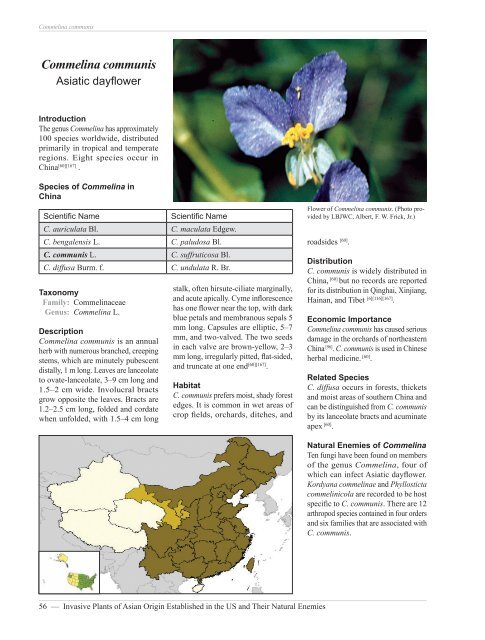

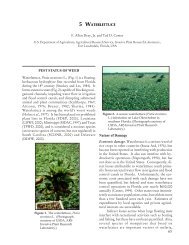

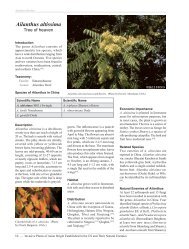
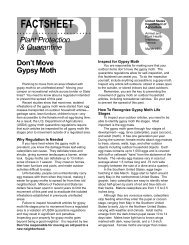
![A Guide to the Control and Management of Invasive Phragmites [PDF]](https://img.yumpu.com/27321025/1/190x190/a-guide-to-the-control-and-management-of-invasive-phragmites-pdf.jpg?quality=85)
